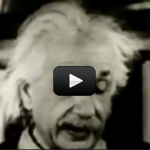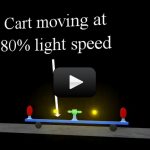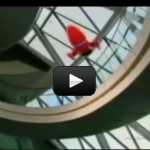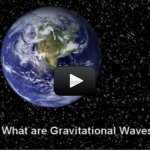Is time travel into the future possible? Are there really such bizarre objects that warp space and freeze time? What about wormholes and tunneling – are those possible? You bet! We’re going to take a sneak peek at the laws of physics that govern these and more in our adventure through relativity.
Select a Lesson
 | Time Dilation and Length Contraction Time dilation is not about clocks or light, it’s about time itself. Measures of time are simply different for different observers in motion relative to each other. |
 | Einstein’s Special Relativity Special Theory of Relativity of Einstein |
 | Two Spaceships Show Time Dilation Time Dilation of two spaceships.. |
 | In a Lightning Storm on a Train The simultaneity of events can get complicated when talking about relativity. Einstein tells us that due to relativity, an event observed by two different reference frames is not observed as simulations if one frame is moving. But what does that mean? It means, for example, that if you are running very fast (near the speed … |
 | Einstein’s Own Words… Albert Einstein was born in a small town in Germany way back in 1879. He was only 21 years old when he published his first paper! However, it was in 1905 when he was 26 that his work really flourished. He published four separate papers all within a few months. In these papers he discovered … |
 | Parallel Lines CAN Intersect! Two parallel lines can intersect if you are in non-Euclidean geometry. It's hard to imagine this one being true, but it is! |
 | Past, Present, Future & Elsewhere When the Mars Rover landed on Mars, it was 11 light minutes from Earth (meaning that it would take a radio signal 11 minutes to get from Earth to Mars). |
 | Visualization of Einstein’s Special Relativity When one thinks about events happening with reference frames moving near the speed of light, he or she can come up with some wierd paradoxes. A paradox is an event which causes a logical impossibility in another frame. Paradoxes in relativity can get complicated, but Einstein’s theory of special relativity gives logical explanations of them. … Continue reading "Visualization of Einstein’s Special Relativity" |
 | Time Travel using Relativity Now that we’ve used light clocks to show how the perception of time changes in different reference frames, let’s look at some really cool applications. Well what’s cooler than time travel? Since a clock moving fast by Earth seems to tick a little slower than a stationary clock on Earth, what happens if the moving … |
 | General Relativity: Gravitational Waves Albert Einstein also predicted the existence of something called gravitational waves. He did this in his theory of general relativity in 1916, and the study still continues today. What is a gravitational wave? Gravitational waves are ripples in the curvature of space-time itself, which propagate as waves away from the source of gravity. These sources … |
